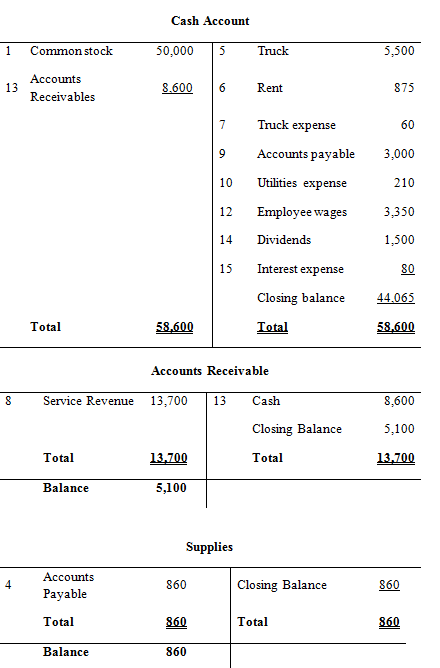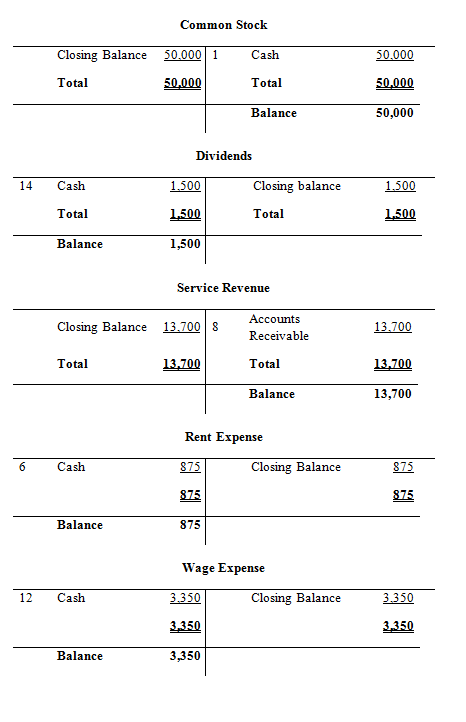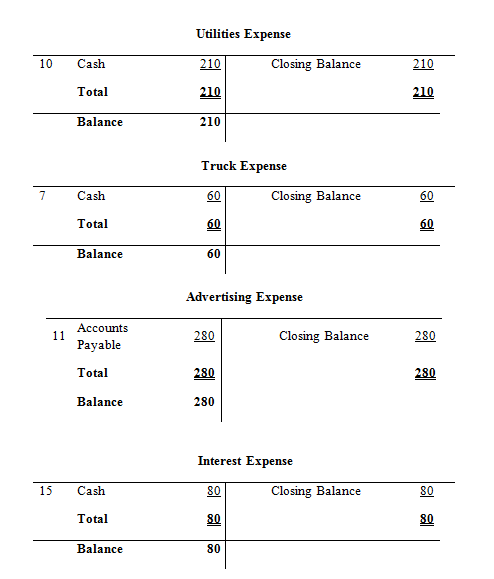
Concept explainers
a.
Prepare journal entries and record the above transactions in T-account.
a.
Explanation of Solution
Journal entry is a set of economic events which can be measured in monetary terms. These are recorded chronologically and systematically.
Accounting rules for Journal entries:
- To record increase balance of account: Debit assets, expenses, losses and credit liabilities, capital, revenue and gains.
- To record decrease balance of account: Credit assets, expenses, losses and debit liabilities, capital, revenue and gains.
T-account:
T-account is the form of the ledger account, where the journal entries are posted to this account. It is referred to as the T-account, because the alignment of the components of the account resembles the capital letter ‘T’.
Record the journal entries for the month of May date from May 1 to May 15.
| Date | Account Title and Explanation |
Debit ($) | Credit ($) | ||
| May 1 | Cash | 50,000 | |||
| Common Stock | 50,000 | ||||
| ( To record the issue of | |||||
| Common stock.) | |||||
Table (1)
| Date | Account Title and Explanation |
Debit ($) | Credit ($) | ||
| May 2 | Equipment | 4,200 | |||
| Accounts Payable | 4,200 | ||||
| (To record the purchase of | |||||
| Equipment on account.) | |||||
Table (2)
| Date | Account Title and Explanation |
Debit ($) | Credit ($) | ||
| May 3 | Accounts Payable | 200 | |||
| Equipment | 200 | ||||
| (To record the return of | |||||
| Equipment.) | |||||
Table (3)
| Date | Account Title and Explanation |
Debit ($) | Credit ($) | ||
| May 4 | Supplies | 860 | |||
| Accounts Payable | 860 | ||||
| (To record the purchase of | |||||
| Supplies on account.) | |||||
Table (4)
| Date | Account Title and Explanation |
Debit ($) | Credit ($) | ||
| May 5 | Truck | 10,500 | |||
| Cash | 5,500 | ||||
| Note Payable | 5,000 | ||||
| (To record the purchase of | |||||
| Cash and note payable.) | |||||
Table (5)
| Date | Account Title and Explanation |
Debit ($) | Credit ($) | ||
| May 6 | Rent | 875 | |||
| Cash | 875 | ||||
| ( To record the payment | |||||
| Of rent.) | |||||
Table (6)
| Date | Account Title and Explanation |
Debit ($) | Credit ($) | ||
| May 7 | Truck expense | $60 | |||
| Cash | $60 | ||||
| ( To record the expense | |||||
| of fuel cost made for the | |||||
| Truck.) | |||||
Table (7)
| Date | Account Title and Explanation |
Debit ($) | Credit ($) | ||
| May 8 | 13,700 | ||||
| Service Revenue | 13,700 | ||||
| (To record the billing made | |||||
| For the services rendered.) | |||||
Table (8)
| Date | Account Title and Explanation |
Debit ($) | Credit ($) | ||
| May 9 | Accounts Payable | 3,000 | |||
| Cash | 3,000 | ||||
| (To record the payment for | |||||
| the purchase of | |||||
| Equipment.) | |||||
Table (9)
| Date | Account Title and Explanation |
Debit ($) | Credit ($) | ||
| May 10 | Utilities expense | 210 | |||
| Cash | 210 | ||||
| (To record the utilities | |||||
| Expense.) | |||||
Table (10)
| Date | Account Title and Explanation |
Debit ($) | Credit ($) | ||
| May 11 | Advertising Expense | 280 | |||
| Accounts Payable | 280 | ||||
| ( To record the advertising | |||||
| expense to be paid on | |||||
| June.) | |||||
Table (11)
| Date | Account Title and Explanation |
Debit ($) | Credit ($) | ||
| May 12 | Employee Wages | 3,350 | |||
| Cash | 3,350 | ||||
| ( To record the payment | |||||
| Of employee wages.) | |||||
Table (12)
| Date | Account Title and Explanation |
Debit ($) | Credit ($) | ||
| May 13 | Cash | 8,600 | |||
| Account Receivables | 8,600 | ||||
| (To record the collection | |||||
| Of account receivables.) | |||||
Table (13)
| Date | Account Title and Explanation |
Debit ($) | Credit ($) | ||
| May 14 | Dividends | 1,500 | |||
| Cash | 1,500 | ||||
| (To record the payment of | |||||
| Dividends amount.) | |||||
Table (14)
| Date | Account Title and Explanation |
Debit ($) | Credit ($) | ||
| May 15 | Interest Expenses | 80 | |||
| Cash | 80 | ||||
| (To record the payment | |||||
| Of interest expenses.) | |||||
Table (15)
Record the above transactions in to T-accounts:
Prepare T- accounts




b.
Prepare
b.
Explanation of Solution
Trial balance:
Trial balance is the summary of accounts, and their debit and credit balances at a given time. It is usually prepared at end of the accounting period. Debit balances are listed in left column and credit balances are listed in right column. The totals of debit and credit column should be equal. Trial balance is useful in the preparation of the financial statements.
| JB Company | ||
| Trial Balance as of May 31 | ||
| Particulars | Amount ($) | Amount ($) |
| Cash | 44,025 | |
| Accounts Receivable | 5,100 | |
| Supplies | 860 | |
| Equipment | 4,000 | |
| Truck | 10,500 | |
| Accounts Payable | 2,140 | |
| Notes Payable | 5,000 | |
| Common Stock | 50,000 | |
| Dividends | 1,500 | |
| Service Revenue | 13,700 | |
| Rent Expense | 875 | |
| Wage Expense | 3,350 | |
| Utilities Expense | 210 | |
| Truck Expense | 60 | |
| Advertising Expense | 280 | |
| Interest Expense | 80 | |
| Total | 70,840 | 70,840 |
Table (16)
Want to see more full solutions like this?
Chapter 2 Solutions
Financial Accounting for Undergraduates
- Please provide the solution to this general accounting question using proper accounting principles.arrow_forwardI am looking for help with this general accounting question using proper accounting standards.arrow_forwardPlease provide the accurate answer to this general accounting problem using appropriate methods.arrow_forward
- I need guidance with this financial accounting problem using the right financial principles.arrow_forwardI need help finding the accurate solution to this general accounting problem with valid methods.arrow_forwardCan you explain the correct methodology to solve this general accounting problem?arrow_forward
- Please help me solve this financial accounting problem with the correct financial process.arrow_forwardI need assistance with this general accounting question using appropriate principles.arrow_forwardI am trying to find the accurate solution to this general accounting problem with appropriate explanations.arrow_forward

 AccountingAccountingISBN:9781337272094Author:WARREN, Carl S., Reeve, James M., Duchac, Jonathan E.Publisher:Cengage Learning,
AccountingAccountingISBN:9781337272094Author:WARREN, Carl S., Reeve, James M., Duchac, Jonathan E.Publisher:Cengage Learning, Accounting Information SystemsAccountingISBN:9781337619202Author:Hall, James A.Publisher:Cengage Learning,
Accounting Information SystemsAccountingISBN:9781337619202Author:Hall, James A.Publisher:Cengage Learning, Horngren's Cost Accounting: A Managerial Emphasis...AccountingISBN:9780134475585Author:Srikant M. Datar, Madhav V. RajanPublisher:PEARSON
Horngren's Cost Accounting: A Managerial Emphasis...AccountingISBN:9780134475585Author:Srikant M. Datar, Madhav V. RajanPublisher:PEARSON Intermediate AccountingAccountingISBN:9781259722660Author:J. David Spiceland, Mark W. Nelson, Wayne M ThomasPublisher:McGraw-Hill Education
Intermediate AccountingAccountingISBN:9781259722660Author:J. David Spiceland, Mark W. Nelson, Wayne M ThomasPublisher:McGraw-Hill Education Financial and Managerial AccountingAccountingISBN:9781259726705Author:John J Wild, Ken W. Shaw, Barbara Chiappetta Fundamental Accounting PrinciplesPublisher:McGraw-Hill Education
Financial and Managerial AccountingAccountingISBN:9781259726705Author:John J Wild, Ken W. Shaw, Barbara Chiappetta Fundamental Accounting PrinciplesPublisher:McGraw-Hill Education





